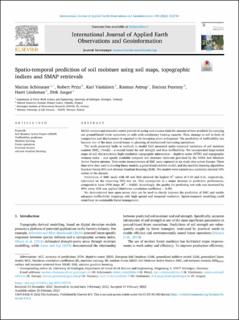| dc.contributor.author | Schönauer, Marian | |
| dc.contributor.author | Prinz, Robert | |
| dc.contributor.author | Väätäinen, Kari | |
| dc.contributor.author | Astrup, Rasmus Andreas | |
| dc.contributor.author | Pszenny, Dariusz | |
| dc.contributor.author | Lindeman, Harri | |
| dc.contributor.author | Jaeger, Dirk | |
| dc.date.accessioned | 2022-10-11T08:50:43Z | |
| dc.date.available | 2022-10-11T08:50:43Z | |
| dc.date.created | 2022-05-10T14:20:19Z | |
| dc.date.issued | 2022-02-23 | |
| dc.identifier.citation | International Journal of Applied Earth Observation and Geoinformation. 2022, 108 1-9. | en_US |
| dc.identifier.issn | 1569-8432 | |
| dc.identifier.uri | https://hdl.handle.net/11250/3025304 | |
| dc.description.abstract | Milder winters and extended wetter periods in spring and autumn limit the amount of time available for carrying out ground-based forest operations on soils with satisfactory bearing capacity. Thus, damage to soil in form of compaction and displacement is reported to be becoming more widespread. The prediction of trafficability has become one of the most central issues in planning of mechanized harvesting operations. The work presented looks at methods to model field measured spatio-temporal variations of soil moisture content (SMC, [%vol]) – a crucial factor for soil strength and thus trafficability. We incorporated large-scaled maps of soil characteristics, high-resolution topographic information – depth-to-water (DTW) and topographic wetness index – and openly available temporal soil moisture retrievals provided by the NASA Soil Moisture Active Passive mission. Time-series measurements of SMC were captured at six study sites across Europe. These data were then used to develop linear models, a generalized additive model, and the machine learning algorithms Random Forest (RF) and eXtreme Gradient Boosting (XGB). The models were trained on a randomly selected 10% subset of the dataset. Predictions of SMC made with RF and XGB attained the highest R2 values of 0.49 and 0.51, respectively, calculated on the remaining 90% test set. This corresponds to a major increase in predictive performance, compared to basic DTW maps (R2 = 0.022). Accordingly, the quality for predicting wet soils was increased by 49% when XGB was applied (Matthews correlation coefficient = 0.45). We demonstrated how open access data can be used to clearly improve the prediction of SMC and enable adequate trafficability mappings with high spatial and temporal resolution. Spatio-temporal modelling could contribute to sustainable forest management. | en_US |
| dc.language.iso | eng | en_US |
| dc.publisher | Elsevier B.V. | en_US |
| dc.rights | Attribution-NonCommercial-NoDerivatives 4.0 Internasjonal | * |
| dc.rights.uri | http://creativecommons.org/licenses/by-nc-nd/4.0/deed.no | * |
| dc.title | Spatio-temporal prediction of soil moisture using soil maps, topographic indices and SMAP retrievals | en_US |
| dc.title.alternative | Spatio-temporal prediction of soil moisture using soil maps, topographic indices and SMAP retrievals | en_US |
| dc.type | Peer reviewed | en_US |
| dc.type | Journal article | en_US |
| dc.description.version | publishedVersion | en_US |
| dc.rights.holder | © 2022 The Author(s) | en_US |
| dc.source.pagenumber | 1-9 | en_US |
| dc.source.volume | 108 | en_US |
| dc.source.journal | International Journal of Applied Earth Observation and Geoinformation | en_US |
| dc.identifier.doi | 10.1016/j.jag.2022.102730 | |
| dc.identifier.cristin | 2023160 | |
| dc.relation.project | EC/H2020/720757 | en_US |
| dc.source.articlenumber | 102730 | en_US |
| cristin.ispublished | true | |
| cristin.fulltext | original | |
| cristin.qualitycode | 1 | |

